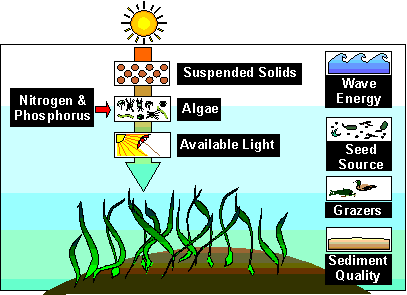Bay Grasses (Submerged Aquatic Vegetation)
Factors Affecting Growth of Bay Grasses
 |
- Available Light
Light is the single most important factor affecting bay grass growth. Photosynthesis, the process whereby plants convert carbon dioxide (CO2) from the atmosphere into a useable form of energy, is a light dependent process. Therefore, there must be adequate light reaching the bottom of a body of water for bay grasses to grow. In areas with high concentrations of suspended solids and algae, almost all available light is absorbed or scattered preventing growth of bay grasses.
- Nitrogen and Phosphorus
Like all plants, bay grasses need a certain amount of nutrients including nitrogen and phosphorus to grow. However, excess nutrients can cause adverse effects and bay grasses can suffer as a result. Plant and animal matter (including human waste), fertilizer, and even deposition from car exhaust contribute nutrients to the bay. The excess nutrients promote the growth of algae in the water column, which reduce or block the amount of light available for bay grass survival.
- Algae
Nutrients encourage the growth of plants. However, excess nutrients can cause increases in algae, microscopic floating plants. Where there is too much algae, the water becomes cloudy and blocks the light needed by bay grasses. Algae can also coat the leaves of bay grasses, further reducing the amount of light received by the plants.
- Suspended Solids
Small particles in the water, like silt, scatter and absorb light as they pass through the water column. These particles come from land erosion, and disturbances to the bottom of the bay. Turbidity is a measure of how clear the water is and how much the suspended solids hinder the passage of light. In areas of high turbidity, or increased suspended solids, bay grasses do not receive adequate light for survival.
- Wave Energy
Bay grasses do not typically grow in areas with heavy wave action due to bottom scouring and resuspension of fine particles.
- Seed Source
Seed sources or other reproductive structures are necessary for bay grasses to reproduce. Without a source of seed in a given area or upstream of an area, bay grasses will not exist. There are many regions within Chesapeake Bay in which habitat conditions are suitable for bay grass growth, but are currently lacking vegetation, probably due to a lack of adequate seed or propagule source. The department is currently working to identify these places, and target them for reseeding efforts.
- Grazing
Several species living in and around the bay including the cow-nose ray, mute swans, and other waterfowl can cause significant damage to bay grass populations by feeding directly on the vegetative (leaves and stems) and reproductive (seeds and propagules) structures of bay grasses. A single adult mute swan has been know to consume 8 pounds of bay grass a day!
- Sediment Quality
Bay grasses require sediment to provide mechanical support of roots and sufficient nutrients. Although preferences for particular sediment type varies among species, most prefer more stable sediments composed of sand or mud with low organic matter content.
>> Back to Bay Grass Home <<

